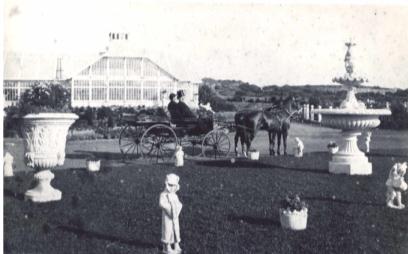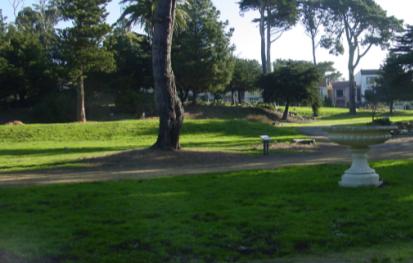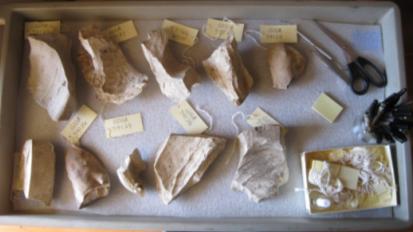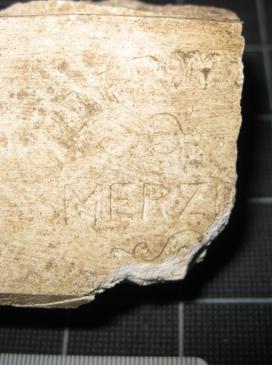For visitors and local residents alike, Land's End is one of the most popular and beloved destinations in the Golden Gate National Recreation Area. The mysterious ruins at Sutro Baths beckon to us to explore their secrets and think about days gone by. Visitors who wander a little farther from the beaten path know that one of the prettiest sunset views in the city can be found on the Parapet in Sutro Heights Park.
Although the breathtaking backdrop of the Pacific Ocean has remained the same, Land's End looks very different today than it once did. Did you know that at one time, the area was literally covered with beautiful Victorian buildings, formal gardens, and statuary? The photo below shows what the area by the old Sutro Heights Conservatory looked like at the height of its popularity in the mid-1880s:
At this time, Land's End was owned by wealthy mining engineer and one-time mayor of San Francisco, Adolph Sutro. Adolph Sutro was a German immigrant who achieved notoriety and wealth when he developed the acclaimed Sutro Tunnel, which made mining safer for workers in the Comstock Lode. Through clever investments and development projects in San Francisco - including the Sutro Heights and Sutro Baths projects, the Cliff House, and the Cliff House and Ferries Railway - Sutro expanded his wealth and influence.
During the 1880s, Adolph Sutro developed and lived at Sutro Heights, which he decorated with beautiful gardens and copies of European urns and statues like you can see in the photograph above. Sutro was a great connoisseur of art and culture, and opened up the gardens surrounding his home to the people of San Francisco. For a small fee, visitors could enter the park for strolls down Lover's Lane, carriage rides down Palm Drive, a visit to the Conservatory, or a trip to the souvenir shop and viewing tower at the Parapet.
Here is a photo of what Sutro Heights looks like today, taken during an archaeological survey of the same area by the old Conservatory in 2010:

So what happened to Sutro Heights? Why does it look so different today? Where did all of the statues go? Where did they come from in the first place? Who made them?
Archaeology can help us answer these questions.
Mystery #1: What happened?
Through historical research, we can identify some events which caused Sutro Heights Park to look so different today than it once did. By the 1930s, many of the glass and wooden buildings at Sutro Heights Park were heavily damaged due to the wet, foggy San Francisco climate. They were systematically torn down and removed by Works Progress Administration (WPA) workers to protect public safety. By this time, many of the statues had disappeared. By 1976 when the National Park Service took over management of the area, only a handful of statues and some vandalized, broken pieces remained. They were removed for conservation and replaced with the replicas you can see on site today.
Some people say local residents carried off the original statues over the years to decorate their gardens. Other people say that the statues were removed and buried in Golden Gate Park.
What do YOU think happened to the statues?
Mystery #2: Where did the statues go?
It turns out that some of the statues didn't move so far after all. Through archaeological excavation and survey over the years, National Park Service staff have learned that some of the statues are still at Sutro Heights…they are buried underground.
Here is a photo of some artifacts that were recovered during an excavation in Sutro Heights in the early 1980s: 
In our museum storage facility for archaeological objects, we have numerous drawers containing artifacts that look like this. Some statuary fragments are recognizably human (hands, feet, and heads of men, women, and children), some are from decorative urns and fountains (scalloped basins, flowers), some are utilitarian (floor tiles and sidewalk borders), and some are still mysteries…
Once artifacts get back to the archaeology lab after excavation, each one is carefully inventoried, measured, and labeled. (DEFINITION: this is called archaeological cataloging). Details are recorded about different attributes of each fragment: Is there design on the statue fragment? Can we identify what type of object it is from (statue, urn, other)? Is there writing on it? What shape is it? How thick is it? What is it made out of? (DEFINITION: this is called archaeological analysis.) These details can help us answer specific research questions: Where did the statues come from? Who made them? We hope that someday, with enough data, we will be able to piece some of the statues back together. (DEFINITION: this is called reconstruction.) If we are able to reconstruct enough of a statue, we may be able to match it to an historic photo and identify it. Gathering data from archaeological artifacts is like that old saying: the whole is greater than the sum of its parts. (FUN FACT: people often think that archaeology is like Indiana Jones, but in reality it is much more painstaking and precise…it often takes three times as long to analyze an artifact as it does to excavate it!) Artifact analysis needs to be slow and careful, but it can be when some of the most exciting discoveries in archaeology happen.
Mystery #3: Where did they come from? Who made them?
Recently, as we were cataloging statuary fragments from Sutro Heights Park, we noticed that one small fragment had faint writing on it: 
On close inspection, you can see the words "VILLEROY &" (broken off at "&"), with a curly-cue design below, with "MERZI…" written underneath (broken off at the "I"), and another curly-cue below that. (DEFINITION: this is called a maker's mark, and is typically used by glass and ceramics manufacturers to brand their products with the company name). Once we completed some preliminary research, we were able to identify the mark as: "VILLERY & BOCH/ MERZIG". Villeroy and Boch is a German ceramic manufacturing company founded in 1748 (FUN FACT: one of Eugen von Boch's hobbies was archaeology). In 1879, they expanded ceramics production to a town on the Saar river called Merzig, and began producing terracotta art pieces for gardens and famous homes (FUN FACT: some of these are at "Mad King Ludwig's" castle Herrenchiemsee in Bavaria.). Check out Villeroy and Boch'swebsite for more information.
Given that Adolph Sutro was a German immigrant who liked European architecture, had expensive tastes, and developed Sutro Heights in the early 1880s, finding this maker's mark makes perfect sense! We were excited to discover the first known makers mark on an archaeological statue fragment from Sutro Heights, and even more excited when we learned about our connection to the fascinating company that manufactured it!
Stay tuned in the upcoming weeks for more installments of "Archaeology Behind the Scenes" as we uncover more about the exciting history of the "Mysterious Statues at Land's End"!
